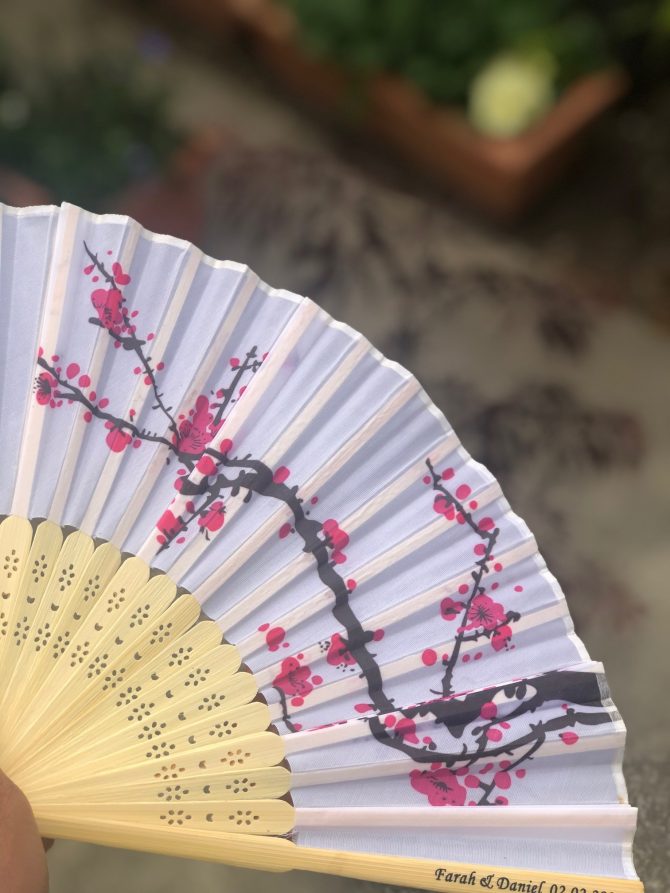Who would have thought that a simple abaniko or hand-held fan could convey one’s thoughts and emotions? That it would be used to declare one’s affection or worse, break someone’s heart. This unconventional way of communication was popularly used during the Spanish time in the Philippines. When the country was under a strict and conservative Catholic rule, women were required to maintain their modesty and propriety at all times, and were not allowed to mingle or sit next to men. If a woman needs to leave house to attend a social occasion, a chaperone had to accompany her to keep an eye on her. Such was the courtship challenge at that time and to get around this predicament, women and men found creative ways to communicate - the abaniko, an accessory to Filipino women’s fashion ensemble, played a big part on this.
The Filipino abaniko or hand-held fan came from the Spanish word “abanico” which means fan. It was made from lace or pineapple silk and its handles were made from the finest wood.
Each abaniko was intricately designed and hand-woven and adorned with brass and a tassel. It completes the Baro’t saya, the traditional costume of the Filipino women.
During the Spanish era, on formal occasions, ladies wore their baro’t saya and brought their abanikos to cool them down, especially on warm sunny days. This eventually turned into an effective tool to communicate with the opposite sex who had no chance of talking to the women under their chaperone’s watchful eyes. With the abaniko the messages had been delivered silently and discreetly.
Ambeth Ocampo, a respected historian in the Philippines, in his essay “Prewar Lover’s Guide” and article Fan Language described some of the messages you can do with your fan:
- Carry it dangling from the right hand = I’d like to have a boyfriend
- Carry it dangling from the left hand = I already have a boyfriend
- Fan constantly = I love you a lot
- Fan slowly = You don’t mean anything to me
- Fold suddenly = I like you
- Let it fall = My aim is true
- Cover half the face = Follow me
- To not carry or hide in one’s pocket = I am not interested in your courtship
Women that time needed good memories to remember each gesture correctly and avoid sending mixed messages. Under no circumstances must one dangle the fan from the left hand and suddenly fan constantly.
Of course the courtship scene in the Philippines has already evolved since the Spanish era; no more secret messages using the abaniko, chaperones are things of the past and women and men are free to socialise together. The abanikos though, both hand-made ones and the intricately designed ones for souvenirs at weddings, are here to stay. In those hot and humid summer months, when you are outside on the streets or inside a jeep, there's nothing more convenient than having a handy abaniko to pull out from your bags to fan and cool and you down.
Do you want to learn how to make paper abanikos? Scoll down to watch the video:
Filipino
Sinong mag-aakalang ang simpleng abaniko o pamaypay ay s'yang maghahatid ng saloobin o emosyon ng isang tao? Na ito ay magagamit upang ipabatid ang iyong pagmamahal o ang mas masaklap, ang biguin ang isang manililigaw. Itong kakaibang paraan ng komunikasyon ay popular ginagamit noong panahon ng mga Kastila sa Pilipinas. Noong ang bansa ay nasa ilalim ng strikto at konserbatibong pamamalakad ng mga Katoliko, ang mga kababaihan ay kinakailangang palaging panatilhin ang kanilang pagiging mahinhin at propriyedad at hindi maaaring makipagsalamuha o umupo katabi ang mga lalake. Kung ang babae ay kinakailangang lumabas ng bahay upang pumunta sa mga pagtitipon, kadalasan sila ay sinasamahan ng kanilang bantay upang sila ay manmanan. Ito ang hamon ng ligawan noong unang panahon kung kaya’t ang mga kababaihan at kalalakihan ay nakahanap ng paraan upang makapag-usap at ang abaniko, isang aksesorya sa damit ng mga babae ay may mahalagang parte dito.
Ang Filipino abaniko ay galing sa Kastilang salita na “abanico” na ang ibig sabihin ay “fan”. Ito ay yari mula sa lace o piña at ang hawakan ay gawa mula sa pinakamagandang kahoy. Bawa’t isang abaniko ay masusing dinesenyo at pinalamutian ng brass at tassel. Kinukumpleto nito ang Baro’t saya, ang tradisyunal na damit ng mga kababaihang Pilipina.
Noong panahon ng mga Kastila, tuwing may importanteng salu-salo, nagsusuot ang mga kababaihan ng baro’t saya at bitbit ang kanilang mga abanikong pamaypay lalo na kung mainit ang panahon. Kalaunan ito ang naging gamit upang makipag-usap ang mga babae sa mga lalake na lalo na kung sila ay may mga bantay. Gamit ang abaniko, ang mga mensahe ay naipapadala ng sikreto.
Si Ambeth Ocampo, isang respetadong historian sa Pilipinas, sa kanyang essay na “Prewar Lover’s Guide” at artikulo na Fan Language ay isinalarawan ang mga mensahe na maaari mong magawa gamit ang iyong pamaypay:
- Carry it dangling from the right hand = I’d like to have a boyfriend
- Carry it dangling from the left hand = I already have a boyfriend
- Fan constantly = I love you a lot
- Fan slowly = You don’t mean anything to me
- Fold suddenly = I like you
- Let it fall = My aim is true
- Cover half the face = Follow me
- To not carry or hide in one’s pocket = I am not interested in your courtship
Ang mga kababaihan noong panahon na iyon ay may magagaling na memorya at tanda nila ang bawa’t isang kilos at ang kahulugan ng mga ito upang maiwasan ang pagpadala ng mga nakakalitong mensahe. Hinding-hindi maaari na palawitin mo ang kanyang pamaypay at magpapaypay ng mabilis.
Ang paraan ng panliligaw sa Pilipinas ay malaki na ang pinagbago mula noong panahon ng mga Kastila, wala nang mga mensaheng pa-sikreto gamit ang abaniko, ang magkaroon ng bantay ay nakalipas na, at ang mga babae at lalake ay malaya nang nakikipaghalubilo sa isa’t-isa. Ang abaniko, ang parehong gawa sa kamay at ang may masusing mga disensyo na madalas binibigay sa kasalan as souvenirs, ay naririto pa din. Sa mga buwan ng tag-init, at ikaw ay nasa kalye o nasa loob ng jeep, wala nang giginhawa pa kundi ang mayroon kang mahuhugot na pamaypay sa loob ng iyong bag upang ikaw ay malamigan.
Nais mo bang malaman kung paano gumawa ng abanikong yari sa papel? Panoorin itong video:
Blog posts
- Sipa: A beloved Filipino game
- Filipino Traditional Clothing: Barong Tagalog & Baro’t Saya – and Make your own Filipino Paper Dolls
- National Language Month in the Philippines
- How Filipinos celebrate Philippine Independence Day in Christchurch
- The Legends of the Sarimanok
- Parol making
- Philippine Independence Day at Tūranga 2019
- Philippine Independence Day 2019
Library resources
- Resources in Tagalog
- Philippines
- Mango Languages
- ESOL resources
- Library Filipino books written in Tagalog
- Tagalog eBooks available in Overdrive
Filipino language
- Information for newcomers in Filipino.
- Find books and resources in our collection in Filipino including for children.
- Filipino eBooks can be borrowed from the eBook platform Overdrive.
- Read Filipino language newspapers on PressReader.




Add a comment to: Filipino fan language during the Spanish time in the Philippines